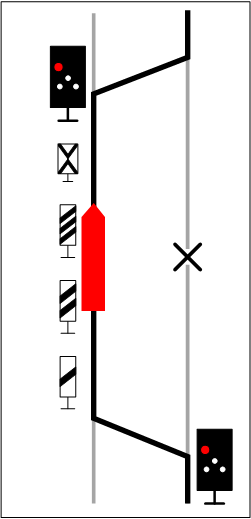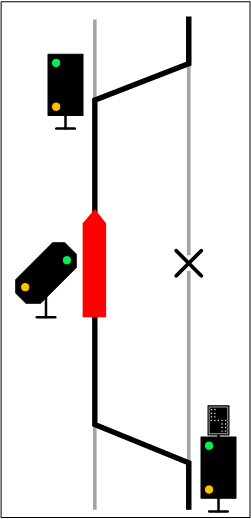
In Germany, on lines with more than one tracks (usually two tracks), usually a train runs on the right-hand track. Some lines are equipped with signalling equipment such that a train may also regularly run on the left-hand track, while other might not have automatic block signals on the left-hand track.
First some terminology:
In DB area (former West Germany), if only the right-hand track is equipped with automatic
block signalling (Strecke ohne Gleiswechselbetrieb), the right-hand track is
called the right (i.e.: correct) track (richtiges Gleis), the left-hand track is
called the wrong track (falsches Gleis).
[Note, that in German, both 'rights' (for 'correct' and 'right-hand') translate
differently, so the above sentence 'right is called right' makes more sense in German than
in English] (Ah, is this why Britons drive on the wrong side of the road?)
If both tracks are equipped with automatic block signalling for both directions (Strecke
mit Gleiswechselbetrieb), the right-hand track is called the regular track (Regelgleis),
the left-hand track is called the counter track (Gegengleis).
In DR area, regardless of block signalling, the terms right-hand track (rechtes Gleis) and left-hand track (linkes Gleis) are used.
Now, what are Falschfahrbetrieb (FB) and Gleiswechselbetrieb (GWB)? Literally, the first translates to wrong-driving-operation(=wrong line operation), the latter means track-switching-operation (bidirectional line operation), i.e. on a GWB line both tracks are equipped with full automatic block signalling. If a train runs on the left-hand (i.e. wrong) line without automatic block signalling, special rules apply, and, if there are signals, special signal aspects will be displayed.
First, I will explain Falschfahrbetrieb/Wrong Line Operation. That is introduced when a
train must use the wrong track due to exceptional circumstances such as a blocked
track or
a construction site, and the remaining single line is not equipped with block signalling
in the counter direction.
If there are no appropriate signals, the Falschfahrbetrieb (FB) entirely relies on written
orders (which I do not cover here).
If there are signals, the procedure is called "Signalisierter Falschfahrbetrieb"
(SFB) or signalled wrong line operation. That works as follows:
SFB is initiated by a main signal showing Hp 0+Zs 8 (Stop+Wrong Line Order Signal). The Zs 8 is not controlled by the interlocking, so it is the signalman's responsibility to ensure that the block is clear.
SFB may proceed with 40 km/h in points area and at maximum with 100 km/h on the open line.
The SFB is withdrawn by either of the following methods:
In case the SFB is to be continued, another Zs 8 is displayed with the main signal.
Example:

Note that most of the signals mentioned in the preceding paragraph were originally placed between the tracks, so you are likely to see it there, and a chequerboard sign to the left of the wrong track
Since with GWB the counter line also has automatic block signalling, GWB is initiated by a main signal showing a proceed aspect (rather than stop as with FB/SFB), combined with a Zs 6 Counter Line Order Signal. Withdrawal of GWB is also done with a main signal showing a proceed aspect.
Example:

 home home |
 signalling
rules & practice signalling
rules & practice |
 email email |
 numbering of signals & tracks numbering of signals & tracks |
 Indusi Indusi |